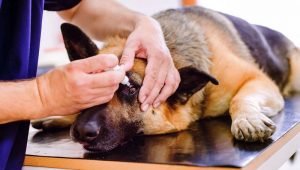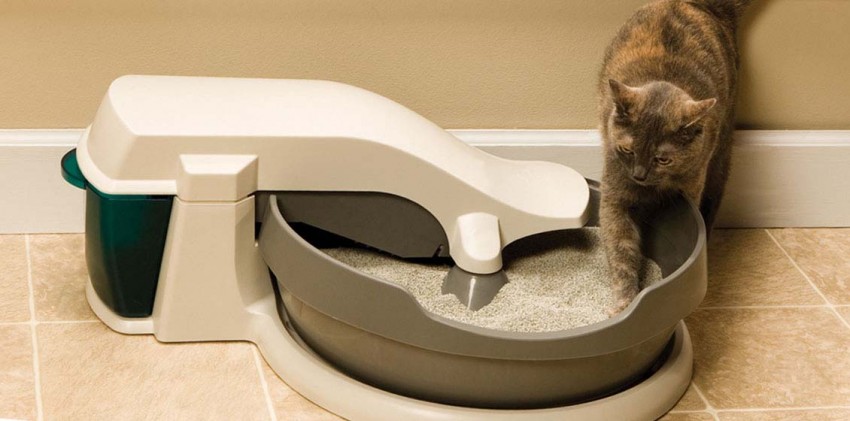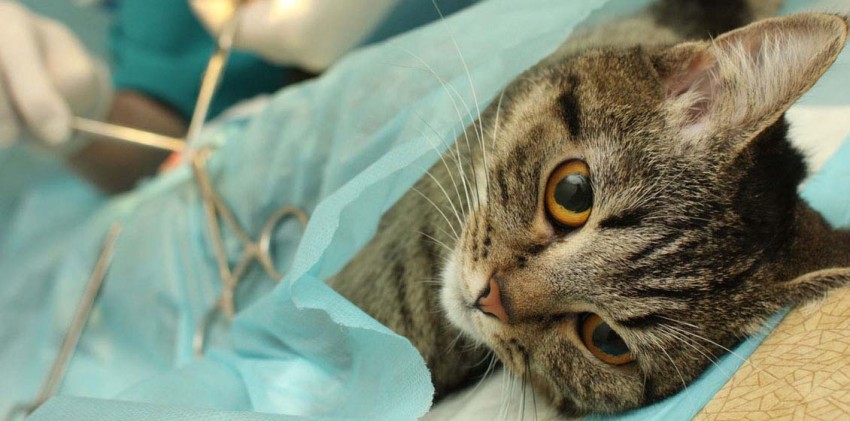Eye injuries in dogs: symptoms and treatment
 Dogs are extremely inquisitive and love to play. Even extremely calm dogs sometimes get scratches and other injuries. This can happen during a game, sneaking through the bushes or simply digging holes. Eye injuries in dogs are a fairly common problem.
Dogs are extremely inquisitive and love to play. Even extremely calm dogs sometimes get scratches and other injuries. This can happen during a game, sneaking through the bushes or simply digging holes. Eye injuries in dogs are a fairly common problem.
More often than other injuries, damage to the eyes requires immediate treatment to the veterinarian ophthalmologist.
You, as the owner of the dog, need to know about the types of injuries to the eyes of the dog and what to do in different cases.
Symptoms of dog eye damage
Some symptoms of visual impairment speak about the problems of the eyes themselves, but it is not always about injuries. There are many eye diseases. Signs of impaired performance can occur in one or both eyes. If your dog has vision problems caused by injury or another cause, you may experience the following symptoms:
The dog squints or eyelids twitches
The dog can not open his eyes
The dog rubs his eyes on objects or paw
Excessive tearing
The dog blinks fast
Yellow or green discharge from the eyes
Bloodshot eyes or redness of the white part (conjunctiva) eyes
Redness of the mucous membrane around the eye
Blurred or discolored eyes
Photophobia, increased sensitivity to light
Prolonged dilation, prolonged constriction of the pupil or other abnormal condition
Asymmetrical eyes
Swelling of the eye
Sunken eyes
Bleeding from the eye area
If you find your pet has one or more signs, we recommend that you contact your veterinarian ophthalmologist.
It is not recommended to try to treat eye diseases of dogs at home without being examined by a veterinarian!
Sometimes eye diseases in dogs can be harder than they appear at first glance. The disease can develop very quickly, usually eye damage is quite painful.
Do not risk the vision of the dog and do not leave her to suffer from pain – consult your veterinarian!
Types of Dog Eye Injuries
Eye damage occurs when an object touches the eye of the dog and injures it. Eye injuries occur after a fight or “quarrel” with another dog. An animal bite, a cat’s claw, a horse’s hoof finally can easily cause an eye injury.
Many things in nature can cause eye injuries: twigs, insect bites, dirt — these are just a few causes of eye injuries in dogs. Dogs that stick their heads out of the window of a moving car can suffer from specks that get into their eyes at speed.
Chemicals sprayed near your dog can also cause eye injuries. Your dog may hit an object or be injured by a sharp object (the corners of the furniture, fence, fish hook, tools, etc.), damaging the eyes. There are many other dangers that can damage the eyes of an animal — fireworks, hot coals, and so on. The dog can injure eyes, trying to scratch his head with paws or other objects.
Eye injuries can be moderate or severe. One or both eyes may be affected. You can not always see how hard the injury is, just by examining the eyes of the dog.
Damage to the cornea – cut or scratch the surface of the eye
Corneal ulcers – from chemistry or specks, or secondary, if the dog scratches his eyes
Puncture – often from teeth, canines or foreign objects
The gap of the century – happens when a dog pulls an eye on an object
Exophthalmos – loss of the dog’s eye from the orbit; most common in brachycephalic (flat-faced dogs) such as pugs and shih-tzu
Treatment of dog eye injuries
If you think your dog has an eye injury, contact your ophthalmologist as soon as possible.
Do not try to treat your eyes yourself at home, if you have not received instructions from a veterinarian before.
As a first aid for eye injuries, you may need to wash your eyes or apply a cold compress. Do this only if the veterinarian has advised this to you!
Since the damaged eye most likely hurts the dog, you need to be very careful when doing something in the area of the eyes. It is better if someone from home helps you
Use sterile saline to rinse eyes. Do not use contact lens solution or any medical / veterinary drug.
Go to the place where you have good access to the dog. If the dog is small, it will be better to place it on the table.
Wrap a towel around the dog. One person should hold the dog, hugging it with one hand around the body, and the other – around the head. Be careful not to press on the neck. Keep the dog’s eye open with one hand, with the other hand directing the stream of water into the injured eye. Use a small towel to wipe the saline flowing from the eye.
Take the dog to the veterinary ophthalmologist.
The doctor will begin with a survey about the circumstances of the injury and the search for possible causes. Then inspect the damaged eye and assess the health of the animal.



